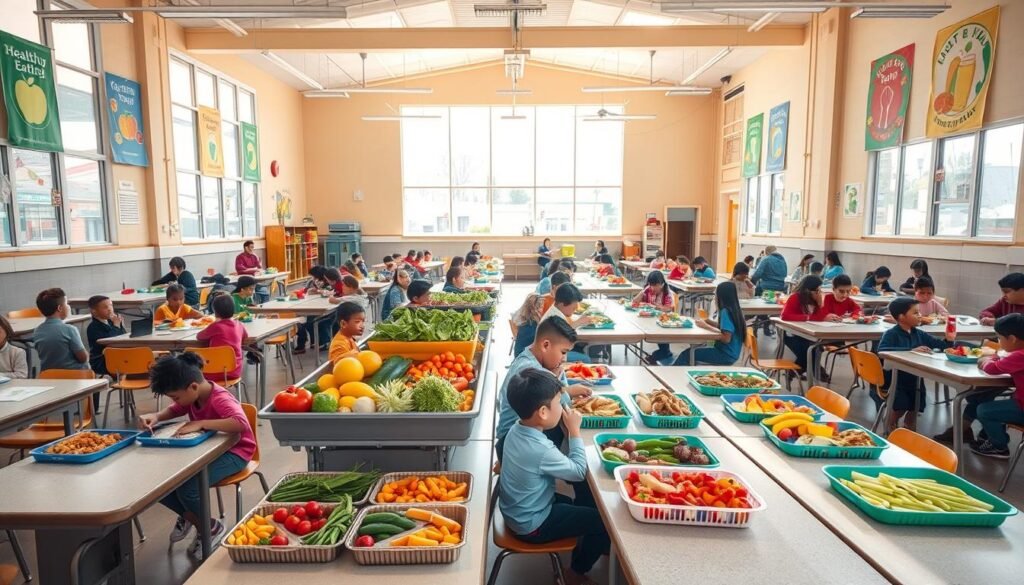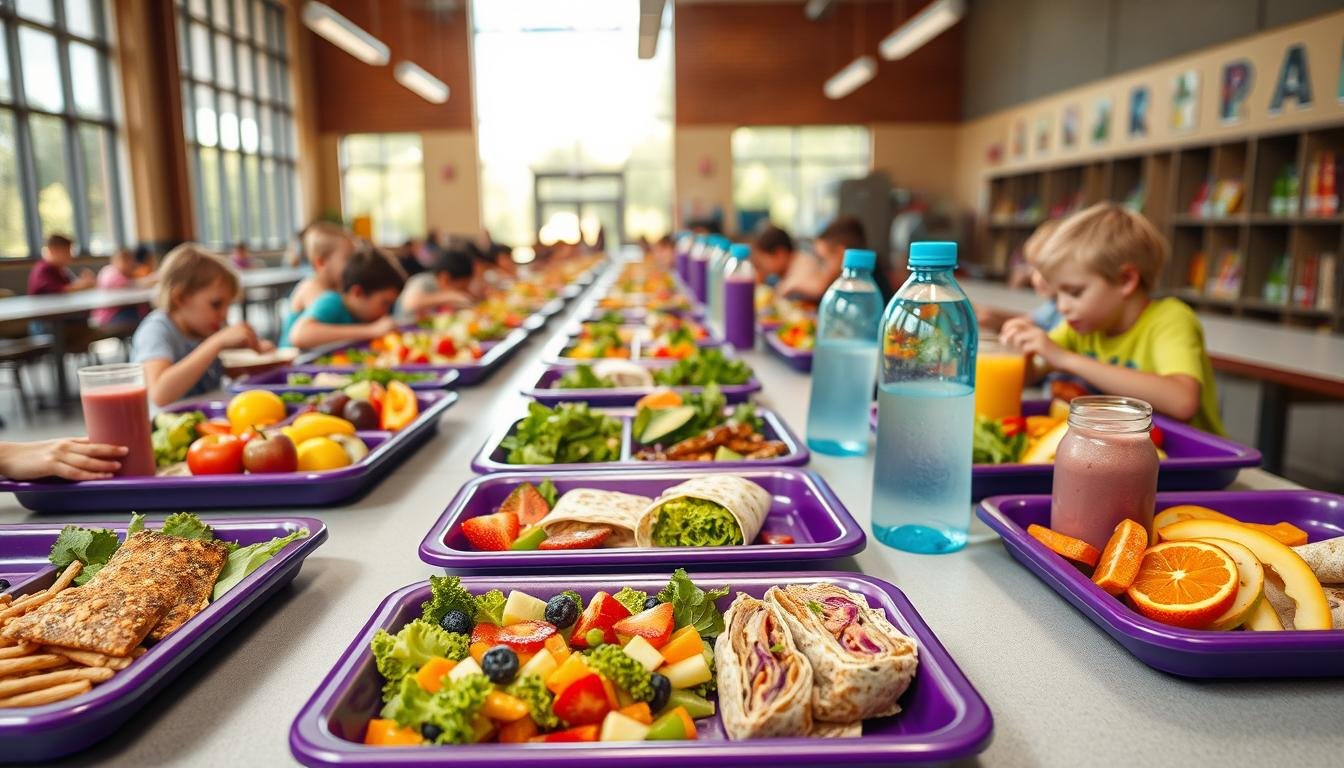Consider the possibility that the key to boosting students’ academic prowess may reside not solely within the confines of the classroom but also within the contents of their lunchboxes. The advent of healthy school catering services is transforming the landscape of school nutrition, ensuring that every pupil is provided with a balanced diet throughout the day. These services are pivotal in addressing food insecurity and encouraging healthier dietary choices among students. Adequate nutrition empowers students to concentrate more intensely, absorb knowledge more efficiently, and flourish both physically and mentally.
Delving into the significance of these services reveals their substantial contribution to nurturing a healthier future generation. Are you prepared to discover the myriad advantages of school catering that transcend mere sustenance of the body? Delve deeper into these flourishing endeavors here.
Key Takeaways
- Healthy school catering services support student wellness and academic success.
- Nutritious meals can tackle food insecurity among children.
- Catering services for schools foster better eating habits.
- Access to balanced nutrition can improve focus and learning outcomes.
- School catering programs promote community engagement and support.
Understanding the Importance of Healthy School Meals
The provision of nutritious meals in educational settings is paramount for the holistic development of students. Studies affirm that the consumption of balanced, wholesome foods significantly enhances cognitive abilities and focus, thereby positively impacting academic outcomes. This underscores the importance of healthy school meals as a critical factor in educational success.
Public health entities stress the imperative for schools to offer nutritious options to combat childhood obesity and foster enduring healthy eating practices. The National School Lunch Program, for example, enforces rigorous standards to guarantee that students receive vital nutrients essential for their growth and development.
- Encouraging good dietary habits is vital.
- Students gain essential vitamins and minerals.
- Healthy meals can reduce behavioral issues.
Recognizing the multifaceted school catering benefits empowers educators and parents to foster a supportive environment for children. This environment encourages the adoption of healthier dietary choices, both within and beyond the school setting. Such initiatives lay the groundwork for a comprehensive educational experience, fostering academic achievement and contributing to the overall health of communities.
The Benefits of School Catering Services
School catering services introduce manifold advantages, significantly enhancing both the student experience and parental convenience. A pivotal benefit lies in the variety of meal options provided. These services offer a diverse menu, meticulously crafted by nutritionists, ensuring students receive well-balanced nutrition. This encourages them to explore a broader spectrum of culinary experiences.
Parents find solace in the convenient meal solutions offered by these services. Catered meals, tailored to meet individual dietary requirements, alleviate the daily burden of meal preparation. This assurance provides peace of mind, knowing their children are consuming nutritious options.
Studies underscore the positive correlation between catered meals and improved student health. The partnership between schools and catering providers often results in higher student satisfaction and consumption rates. This, in turn, enhances energy levels and concentration, positively influencing academic performance.
Furthermore, school catering optimizes kitchen operations, allowing staff to redirect their efforts towards educational objectives. This shift enables schools to concentrate on enriching the learning environment, thereby enhancing overall educational outcomes.
What to Look for in Healthy School Lunch Options
In the evaluation of healthy school lunch options, a multifaceted approach is imperative, focusing on nutritious meal criteria. The inclusion of whole grains, such as brown rice or whole grain bread, is a foundational element. Additionally, fruits and vegetables are indispensable, providing a wealth of vitamins and minerals. Lean proteins, including chicken, turkey, or plant-based alternatives, and low-fat dairy products like yogurt or skim milk, are equally crucial. These components collectively foster balanced nutrition and facilitate effective meal planning throughout the week.
Moreover, the monitoring of added sugars, sodium, and unhealthy fats is paramount. This vigilance ensures that meals adhere to established nutritional benchmarks. Such diligence is essential in maintaining the health and well-being of students.
For the selection of catering services that prioritize healthy options, consulting the USDA’s guidelines is advisable. Resources such as the healthy school lunch ideas offer practical insights into meal planning that aligns with nutritious meal criteria. By prioritizing these elements, lunch options are not only palatable but also contribute to the overall health and well-being of students.
Exploring School Catering Menu Options
The variety of options within a school catering menu is paramount in fostering students’ enjoyment of their meals. Implementing diverse menu options that accommodate different dietary needs, such as vegetarian, vegan, and gluten-free, is essential. This approach respects students’ cultural and personal preferences, transforming lunchtime into a welcoming experience.
Integrating seasonal items into the menu can significantly enhance healthy eating habits. Fresh fruits and vegetables not only offer vital nutrients but also add color to the dishes served. When crafting a school catering menu, consider the following:
- Selection of diverse menu options for all dietary requirements
- Incorporating locally sourced ingredients for freshness
- Offering international dishes to celebrate cultural diversity
Choosing a qualified caterer is crucial for a successful menu. The caterer selection should prioritize those who grasp the nutritional needs of students and emphasize wholesome ingredients. A meticulously curated school catering menu can generate enthusiasm and cultivate a positive relationship with food among students.
Personalized School Meal Plans: Tailoring Nutrition to Individual Needs
Personalized school meal plans are pivotal in addressing the dietary needs accommodations of students. Each child’s nutritional requirements are distinct, influenced by allergies, medical conditions, or personal taste. Catering services collaborate with parents and schools to devise meal plans that are both nutritious and appealing, ensuring student safety.
The objective of nutrition personalization is to integrate diverse dietary preferences into daily meals. This encompasses options for gluten-free, dairy-free, or vegetarian meals, addressing specific health needs. By doing so, schools elevate their meal programs, fostering healthier eating habits among students.
Case studies illustrate the efficacy of personalized meal plans. For example, a school district crafted menus tailored to the unique allergies of several students. This initiative not only boosted student satisfaction but also significantly reduced incidents related to dietary restrictions during lunch. Such achievements underscore the value of collaboration between parents, schools, and catering services in developing effective nutritional personalization strategies.
For further insights and research on this subject, refer to the significance of tailored nutrition in. This resource details how appropriate meal planning can foster healthy development and academic achievement in students.
By emphasizing personalized school meal plans, educational institutions can greatly improve the dining experience. They ensure that every student enjoys nutritious meals that cater to their unique dietary needs.
Affordable School Catering: Maximizing Value Without Compromising Quality

The pursuit of affordable school catering is a paramount objective for educational entities, aiming to deliver wholesome meals without overextending their financial resources. To achieve this, institutions can adopt various methodologies to procure cost-effective meal solutions while maintaining the highest standards of culinary excellence.
Collaboration with local agricultural entities represents a pivotal strategy. By integrating seasonal produce into their culinary offerings, schools can not only reduce expenditure but also elevate the nutritional profile of their meals. Such partnerships often yield substantial cost advantages, facilitated by the economies of scale inherent in bulk procurement.
Additionally, schools can leverage grants and philanthropic contributions to bolster their meal programs. A plethora of organizations dedicate resources to support initiatives focused on school nutrition. By actively seeking out these opportunities, educational establishments can establish a financially sustainable meal provision framework, thereby circumventing the pitfalls of excessive expenditure.
- Form partnerships with local farms to ensure fresh ingredients.
- Utilize seasonal produce for cost savings and quality improvements.
- Research grants aimed at supporting school nutrition programs.
- Encourage community involvement for additional fundraising opportunities.
Engagement with parents and the broader community can catalyze the creation of innovative fundraising initiatives. Such endeavors not only augment the financial capabilities of schools but also contribute to the development of cost-effective meal solutions. Through the implementation of these strategies, educational institutions can provide affordable, nutritious meals that cater to the varied dietary requirements of their student bodies.
School Event Catering: Making Special Occasions Healthy
Catering for special occasions in schools can transform events into healthy celebrations. Through meticulous planning, parents and educators can forge menus that captivate the palate while fostering nutritional well-being. School event catering presents a spectrum of choices that align with the preferences of both students and families, ensuring a universally positive experience.
- Organize a sports day with nutritious snacks like fruit skewers and whole-grain wraps.
- Host fundraisers featuring baked goods made with whole ingredients, minimizing added sugars.
- Celebrate holidays by incorporating traditional dishes that embrace wholesome ingredients.
Many schools have witnessed a positive shift when they choose school event catering that emphasizes health. Parents commend the dedication to well-being, while students relish the delectable meals provided. For further inspiration on healthy dishes, explore delicious healthy meals that can elevate any school occasion.
Healthy catering not only fosters good habits but also underscores the significance of nutrition in social gatherings. By judiciously selecting catering for special occasions, schools establish a precedent for a healthier future.
Choosing the Right School Catering Provider
The selection of a school catering provider is paramount for guaranteeing that students are served nutritious meals that align with their dietary requirements. The evaluation of a school catering provider necessitates a meticulous examination of several critical elements, which collectively signify the caliber and dependability of the catering service.
- Experience and Reputation: Opt for a caterer with a distinguished history in the educational domain. Their expertise profoundly influences the breadth of menu offerings and the overall service excellence.
- Nutritional Standards: Verify that the provider complies with the most current nutritional directives from both local and federal authorities. This is vital for fostering a conducive environment for healthy eating habits.
- Customer Service: Evaluate the caliber of customer support provided. A catering service that places a premium on effective communication is better positioned to address specific school requirements and make necessary adjustments.
- Diversity in Menu Options: Caterers should present a range of choices that cater to various dietary restrictions, encompassing vegetarian, vegan, gluten-free, and allergy-friendly alternatives.
To facilitate the caterer evaluation process, consider employing a checklist that encompasses these criteria. This methodology will empower schools to make well-informed decisions, thereby ensuring quality assurance in catering services. By rigorously scrutinizing potential providers, schools can guarantee that students are served meals that not only fulfill their nutritional needs but also contribute positively to their educational experience.
School Cafeteria Catering: Transforming the Dining Experience

The function of school cafeteria catering transcends the provision of sustenance. It profoundly influences dining experience improvement by establishing environments where students eagerly congregate to partake in their meals. A meticulously crafted cafeteria environment can significantly boost student engagement with nutritious food alternatives, thereby transforming mealtime into a joyous aspect of their academic day.
Effective school cafeteria catering initiatives focus on enhancing aesthetics, such as vibrant menus and seating configurations that foster social interaction. These enhancements cultivate an environment where the exploration of novel culinary experiences becomes an exhilarating journey, enticing students to frequent the cafeteria. Educational institutions that embrace innovative approaches often witness elevated student contentment and a readiness to sample a broad spectrum of culinary offerings.
Implementing a varied and enticing menu is paramount in this metamorphosis. Effective school cafeteria catering integrates fresh, seasonal produce, vegetarian dishes, and international cuisine. This diversity not only caters to diverse palates but also imparts knowledge on nutrition and the significance of cultural culinary diversity.
By emphasizing these aspects, educational institutions can effectively connect with their students, transforming the cafeteria into a dynamic center of activity. Such enhancements cultivate a sense of community, thereby enriching the overall educational experience.
Healthy Ingredients for School Meals
The integration of wholesome ingredients into school meals is paramount for nurturing student well-being. Prioritizing nutrient-dense foods such as whole grains, fresh fruits, and vegetables is essential. The emphasis on local produce not only bolsters community farmers but also elevates the meal’s freshness. The meticulous selection of ingredients is pivotal in designing menus that bolster students’ development and cognitive abilities.
Employing low-fat dairy products ensures balanced nutrition, delivering critical calcium and protein without the burden of excessive fats. The transparency in sourcing ingredients fosters trust among parents and students, underscoring the dedication to quality education in nutrition. This transparency empowers parents to actively promote healthy dietary habits.
Integrating nutrition education into school curricula is crucial. Engaging students in discussions about food origins and health impacts cultivates mindful eating habits. These habits transcend the cafeteria, fostering a broader understanding of nutrition.
- Local Produce: Minimizes carbon footprint and maximizes freshness.
- Whole Grains: Provides essential fiber for better digestion.
- Low-Fat Dairy: Offers vital nutrients with lower fat content.
This comprehensive strategy highlights the critical role of healthy ingredients. It establishes a foundation for a thriving, nutritious school meal program.
Benefits of a School Meal Delivery Service
The ascendance of the school meal delivery service paradigm within the educational and parental spheres is noteworthy. This avant-garde strategy ensures the provision of nutritious meals to students at their residences or designated points of collection. The convenience inherent in this model is profound, liberating parents from the daily burden of meal preparation while guaranteeing their offspring’s nutritional intake.
This service significantly augments the accessibility to wholesome dietary options. Regular consumption of balanced meals fosters improved dietary habits and increases student engagement in mealtime activities. Many households observe a reduction in food waste, as the meals are meticulously crafted to align with individual tastes and dietary restrictions.
The health benefits accruing from a school meal delivery service are substantial. Adequate nutrition is paramount for students’ physical and cognitive advancement, thereby enhancing their academic outcomes. The availability of these meals facilitates optimal energy levels for educational pursuits, enriching the school experience. By opting for a meal delivery service, families are investing in their children’s long-term health and academic success.
Enhancing Nutritional Education Through School Catering
School catering presents a unique opportunity to elevate nutritional education among students. By merging healthy meals with educational initiatives, schools can render learning about food both enjoyable and impactful. Initiatives such as cooking demonstrations and nutrition workshops effectively engage students, fostering a better understanding of healthy eating habits.
Programs that successfully combine catering with nutritional education illustrate the significant school catering impact on students’ attitudes towards food. For instance, case studies reveal that when students participate in meal preparation, their health literacy improves, leading to informed dietary choices.
Another beneficial aspect involves transforming the cafeteria into a learning hub. By offering interactive sessions, students gain hands-on experience and can directly relate lessons to their meals. This approach not only enhances the educational aspect but also strengthens community ties.
Through these initiatives, schools can revolutionize how students perceive food, emphasizing the importance of nutrition in a supportive environment. With each bite, students not only nourish their bodies; they also cultivate a deeper understanding of their health and well-being.
The Role of Parents in School Catering Decisions
Parents are instrumental in molding the school catering environment. Their engagement profoundly impacts the nutritional quality of meals, ensuring students are fed wholesome options. By actively participating in meal planning committees, parents can articulate their desires for nutritious meals. This parents’ role in school catering fosters a dialogue between families and educational institutions.
Engagement with parent-teacher organizations serves as a conduit for advocating for healthier meal choices. Parents’ efforts to improve meal options can positively affect the entire student population. It is imperative for parents to attend school board meetings to voice their opinions on catering services. Their contributions can range from menu suggestions to feedback on current offerings, emphasizing the need for diverse, healthy options.
Strategies for enhancing parental involvement in school catering decisions include:
- Collaborating with local nutritionists to develop meal plans.
- Organizing community events focused on healthy eating.
- Creating surveys to gather input from parents about meal preferences.
Through persistent efforts, parents can profoundly shape school catering, creating an environment that prioritizes student health and well-being.
How to Implement a Successful School Catering Program
The inception of a successful school catering program necessitates a holistic strategy and the articulation of clear objectives. Initiating with a needs assessment is paramount, as it delineates the nutritional exigencies and predilections of the student populace. This initial phase serves as the bedrock, laying the groundwork for the subsequent implementation strategies.
Collaborative efforts are indispensable. The involvement of staff, parents, and students is crucial for fostering a collective sense of responsibility. Through the organization of focus groups or surveys, invaluable insights into meal preferences and dietary constraints can be garnered. Such data is instrumental in shaping the menu, ensuring its congruence with the school’s mission.
Establishing quantifiable objectives is imperative for monitoring advancement. Schools can delineate targets concerning nutritional benchmarks, participation levels, and student contentment. The attainment of these objectives may necessitate the adoption of catering best practices from other districts’ success stories. Such an approach facilitates the optimization of the implementation process, circumventing common obstacles.
Emphasis on perpetual enhancement is paramount. Periodic evaluations of the program, based on student feedback and health metrics, enable schools to refine and evolve. A successful school catering program is characterized by its dedication to fulfilling student needs, fostering healthy dietary habits, and cultivating a convivial dining atmosphere. Drawing inspiration from healthy eating initiatives can catalyze the development of innovative strategies to elevate meal services.
Conclusion
The importance of healthy school catering transcends mere sustenance, embodying a cornerstone for students’ academic success and personal development. The synergy between nutritious meals and student wellness is paramount, underscoring the critical role of quality nutrition in educational environments. This understanding galvanizes schools and parents to support initiatives that prioritize nutritional excellence.
The scope of catering services extends beyond mere provision of sustenance; it encompasses the cultivation of healthier eating habits, the enhancement of the dining experience, and the promotion of nutritional awareness within the school ecosystem. By integrating professional school meal options, educational institutions can empower students to make informed dietary choices, thereby fostering a culture of wellness.
As we progress, a steadfast commitment to healthier meal options and advocacy for effective school catering solutions is imperative. Collaboration between schools and parents is crucial to ensure that children are provided with well-rounded menus that prioritize their health and well-being. For further inspiration on integrating nutritious meals into daily routines, explore the creation of a delightful morning routine with this delicious healthy breakfast that sets a positive tone for the day.
FAQ
What are school catering services?
School catering services deliver nutritionally balanced meals, specifically designed for students. These services ensure that students have access to diverse, healthy options during school hours. The menus are crafted to meet nutritional standards, fostering a culture of healthy eating.
How do I choose the right catering provider for my school?
Selecting a catering provider for your school necessitates an evaluation of their experience, the nutritional value of their offerings, and their capacity to accommodate diverse dietary needs. Additionally, scrutinizing their customer service records is crucial. Utilizing a checklist can streamline this process, ensuring a well-informed decision.
Are personalized school meal plans available?
Indeed, many catering services offer bespoke meal plans tailored to individual dietary requirements, including allergies and specific health needs. This personalization ensures that every student can partake in nutritious, appealing meals.
What are affordable school catering options?
Affordable catering options for schools may involve partnerships with local farms for fresh produce or the use of seasonal ingredients. Such budget-friendly strategies enable the provision of healthy meals without sacrificing quality.
How can school event catering promote healthy eating?
Catering for school events can foster healthy eating habits by offering nutritious meal options during special occasions. This approach helps cultivate a positive food culture among students and parents alike.
What should I look for in a school catering menu?
An exemplary school catering menu should feature a variety of healthy dishes, emphasizing whole grains, lean proteins, fruits, and vegetables. It should also cater to different dietary preferences, such as vegetarian or gluten-free options.
How can catering services enhance nutritional education?
Catering services can significantly contribute to nutritional education by integrating programs that include cooking demonstrations and nutrition workshops. These initiatives enable students to grasp the significance of healthy eating and the importance of nutritious ingredients.
What are the health benefits of a school meal delivery service?
School meal delivery services offer convenience to parents and ensure that students receive nutritious meals at home or designated locations. This approach increases meal participation and reduces food waste.
What impact do healthy school meals have on student performance?
Healthy school meals can profoundly improve student performance by enhancing concentration, cognitive function, and overall well-being. These benefits contribute to superior academic outcomes.
How can parents get involved in school catering decisions?
Parents can actively participate in school catering decisions by joining meal planning committees, advocating for healthier options in school meetings, and collaborating with teachers and administrators. This collective effort promotes the provision of nutritious meals.

